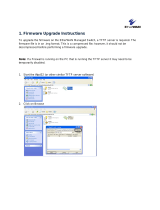
Introduction
12
How the Device Organizes SP Account Parameters
The best way to understand the organization of parameters in your device is to study the parameter layout
on the device web pages. A service provider user account is primarily configured under an SPn Service
menu on the device web page, where n = 1 through 4. There you can configure the AuthUserName and
AuthPasssword parameters of each user account. This task is similar to the user-id and password
parameters found in similar products. Each SP service contains a parameter that points to an ITSPx profile,
where x = A through D. An ITSP profile is where you configure parameters specific to the SP but not specific
to individual user accounts.
The ProxyServer and RegistrationPeriod parameters are examples of such SP-specific
parameters. A device with two user accounts from the same ITSP is configurable on two different SPn
services that refer to the same ITSPx profile. Similarly, two SPn services on one device can share the same
tone definitions if their parameters point to the same Tone Profile.
The following table shows the mapping from some SP account parameter objects to parameter groups on
the device web page.
Sample SP Account Parameter Object Mappings
Provisioning Parameter Object
Parameter Group on Device
Web Page
Notes
VoiceService.1.VoiceProfile.1.Li
ne.n.
(
n = 1,2,3,4)
Voice Services/SP
n Service –
SP
n Service (n = 1,2,3,4)
These three objects (with the
same object instance number
n) completely define an SPn
Service on the web page.
VoiceService.1.VoiceProfile.1.Li
ne.n.SIP. (
n = 1,2,3,4)
Voice Services/SPn Service – SIP
Credentials (n = 1,2,3,4)
VoiceService.1.VoiceProfile.1.Li
ne.n.CallingFeatures. (
n = 1,2,3,4)
Voice Services/SPn Service –
Calling Features (n = 1,2,3,4)
VoiceService.1.VoiceProfile.n.
(n = 1,2,3,4)
ITSP Profile x/General – General
(x = A,B,C,D corr. n = 1,2,3,4)
These four objects (with the
same object instance number
n) together completely define
an ITSP Profile x on the web
page. When an SP Service
refers to ITSP Profile x, it
refers to the four objects as a
group. The SP Service
parameter
X_ServProvProfile binds
the SP service to the ITSP
profile.
VoiceService.1.VoiceProfile.n.Se
rviceProviderInfo.
(n = 1,2,3,4)
ITSP Profile x/General – Service
Provider Info
(x = A,B,C,D corr. n = 1,2,3,4)
VoiceService.1.VoiceProfile.n.SI
P.
(n = 1,2,3,4)
ITSP Profile x/SIP – SIP
(x = A,B,C,D corr. n = 1,2,3,4)
VoiceService.1.VoiceProfile.n.RT
P.
(n = 1,2,3,4)
ITSP Profile x/RTP – RTP
(x = A,B,C,D corr. n = 1,2,3,4)
VoiceService.1.VoiceProfile.1.Li
ne.n.Codec.
(n = 1,2)
Codecs/Codec Profile x
(x = A,B corr. n = 1,2)
The SP Service parameter
X_CodecProfile binds the
SP service to the Codec
Profile.





















